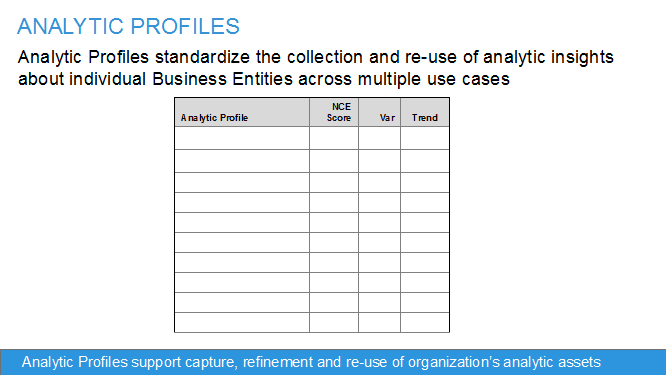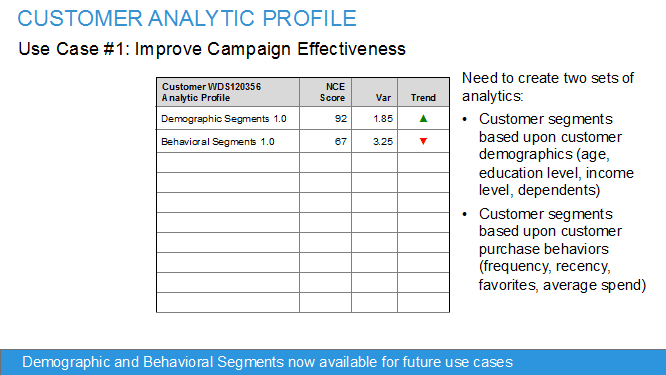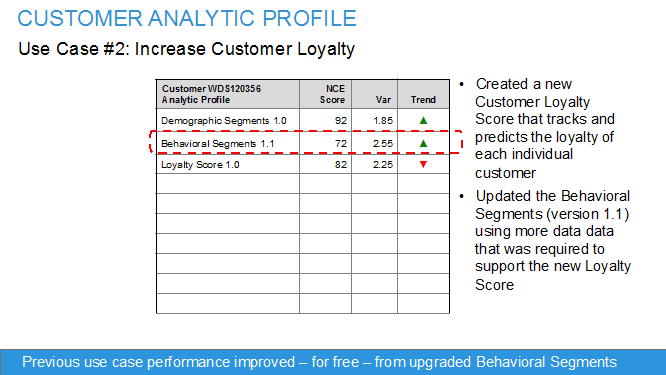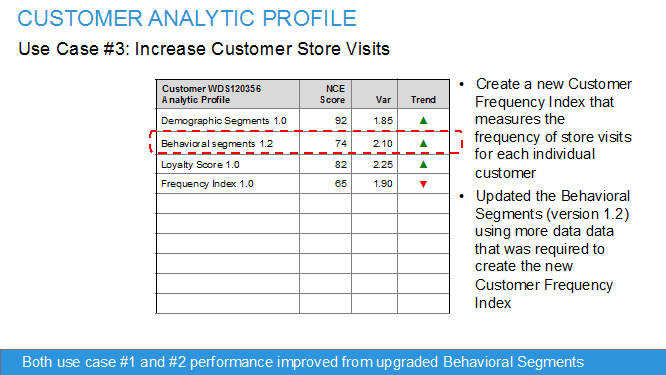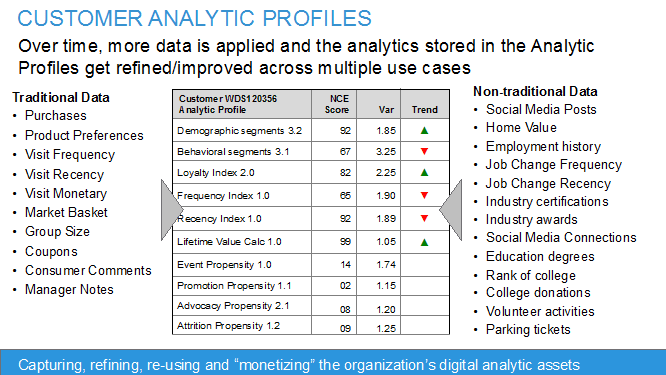Many organizations are associating data monetization with selling their data. But selling data is not a trivial task, especially for organizations whose primary business relies on its data. Organizations new to selling data need to be concerned with privacy and Personally Identifiable Information (PII), data quality and accuracy, data transmission reliability, pricing, packaging, marketing, sales, support, etc. Companies such as Nielsen, Experian and Acxiom are experts at selling data because that’s their business; they have built a business around gathering, aggregating, cleansing, aligning, packaging, selling and supporting data.
So instead of focusing on trying to sell your data, you should focus on monetizing the customer, product and operational insights that are gleaned from the data; insights that can be used to optimize key business and operational processes, reduce security and compliance risks, uncover new revenue opportunities, and create a more compelling customer and partner engagement.
For organizations seeking to monetize their customer, product and operational insights, the Analytic Profile is indispensible. While I have talked frequently about the concept of Analytic Profiles, I’ve never written a blog that details how Analytic Profiles work. So let’s create a “Day in the Life” of an Analytic Profile to explain how an Analytic Profile works to capture and “monetize” your analytic assets.
Analytic Profiles
Analytic Profiles provide a storage model (think key-value store) for capturing the organization’s analytic assets in a way that facilities the refinement and sharing of those analytic assets across multiple business use cases. An Analytic Profile consists of metrics, predictive indicators, segments, scores, and business rules that codify the behaviors, preferences, propensities, inclinations, tendencies, interests, associations and affiliations for the organization’s key business entities such as customers, patients, students, athletes, jet engines, cars, locomotives, CAT scanners, and wind turbines (see Figure 1).
Analytic Profiles enforce a discipline in the capture and re-use of analytics insights at the level of the individual key business entity (e.g., individual patient, individual student, individual wind turbine). The lack of an operational framework for capturing, refining and sharing the analytics can lead to:
- Inefficient use of data engineering and data science resources
- Analytics projects unattached to high value business initiatives
- Limited organizational learning capture and application
- Difficulty gaining organizational buy-in for investments in analytic technologies, resources, and skillsets
- Difficulty building credibility as a trusted business advisor
- Lack of re-usable assets that make future use cases more cost efficient and dramatically increase Return on Investment (ROI)
Let’s see how an Analytic Profile works.
Analytic Profiles in Action
Let’s say that you are the Vice President of Analytics at an organization that tracks individual purchase transactions via a registered on-line account and/or a loyalty program (e.g., retail, hospitality, entertainment, travel, restaurant, financial services, insurance). You’ve been asked to apply data and analytics to help the organization “increase same location sales” by 5%.
After executing a Vision Workshop (very smart move, by the way!) to identify, validate, prioritize and align the business stakeholders around the key business use cases, you’ve come up with the following business use cases for the “Increase Same Location Sales” business initiative:
- Use Case #1: Improve Campaign Effectiveness
- Use Case #2: Increase Customer Loyalty
- Use Case #3: Increase Customer Store Visits
- Use Case #4: Reduce Customer Attrition
“Improve Campaign Effectiveness” Use Case
To support the “Improve Campaign Effectiveness” use case, the data science team worked with the business stakeholders to brainstorm, test and confirm that they needed to build Demographic and Behavioral Segments for each individual customer. The Demographic segments are based upon customer variables such as age, gender, marital status, employment status, employer, income level, education level, college degrees, number of dependents, ages of dependents, home location, home value, work location and job title. The Behavioral segments are based upon purchase and engagement transactions such as frequency of purchase, recency of purchase, items purchased, amount of money spent, coupons or rebates used, discounts applied, returns and consumer comments.
Figure 2 shows the Customer Analytic Profile for Customer WDS120356 resulting from the “Increase Campaign Effectiveness” use case.
Note: a customer will NOT be in a single Demographic or Behavioral segment, but will likely reside in numerous different Demographic and Behavioral segments based upon combinations of the demographic attributes and purchase activities.
As a result of this use case, we have created and captured in the Analytic Profile numerous demographic and behavioral segments for each individual customer. These demographic and behavioral segments are now available across different use cases.
“Improve Customer Loyalty” Use Case
The next use case is “Increase Customer Loyalty.” The data science team again begins the process by brainstorming with the business stakeholders to “identify the variables and metrics that might be better predictors of customer loyalty.” The data science team starts the analytics process by re-using the data that was placed into the data lake for use case #1, but gathers additional data to support the development, testing and refinement of a Customer Loyalty Score.
As part of their analytic modeling process, the data science team decides that the Behavioral Segments created for use case #1 can be re-used to support the “Increase Customer Loyalty” use case, but find that they can improve the predictive capabilities of the Behavioral Segments with the additional data.
Consequently, the data science team completes two tasks in support of the “Increase Customer Loyalty” use case:
- Creates a new Customer Loyalty Score comprised of data from the use case #1 plus new data sources
- Improves the predictive capabilities of the pre-existing Behavioral Segments (now version controlled as version 1.1)
Figure 3 shows the updated Customer Analytic Profile for Customer WDS120356 resulting from the “Increase Customer Loyalty” use case.
It is critical to note that the beneficiary of the improved Behavioral Segments – at no additional cost – is use case #1: Improve Campaign Effectiveness. That is, the performance and results of the “Increase Campaign Effectiveness” use case just improved at no additional cost!
In order to realize this benefit, the analytics captured in the Analytic Profiles must be treated like software and include support for software development techniques such as check-in/check-out, version control and regression testing (using technologies such as Jupyter Notebooks and GitHub).
“Increase Customer Store Visits” Use Case
Let’s go through one more use case: “Increase Customer Store Visits.” The data science team again begins the process by brainstorming with the business stakeholders to “identify the variables and metrics that might be better predictors of customer visits.” The data science team again starts the analytics process by re-using the data that was placed into the data lake for use cases #1 and #2, but gathers additional data to support the development, testing and refinement of a Customer Frequency Index.
As part of their analytic modeling process, the data science team again decides that the Behavioral Segments updated for use case #2 can be re-used to support the “Increase Customer Store Visits” use case, and they find that they can again improve the predictive capabilities of the Behavioral Segments with the additional data necessary to support the “Increase Customer Store Visits” use case.
Figure 4 shows the updated Customer Analytic Profile for Customer WDS120356 resulting from the “Increase Customer Store Visits” use case.
Again, the beneficiary of the updated Behavioral Segments – at no additional cost – are use cases #1 and #2 that find that the performance and results of those use case just improved at no additional cost.
Analytic Profiles Summary
Proceeding use case-by-use case, the Customer Analytic Profiles gets fleshed out and provide the foundation for data monetization through the results of improved business and operational processes and reduced security and compliance risks (see Figure 5).
The Analytic Profiles also provide the foundation for identifying new revenue opportunities; to understand your customer and product usage behaviors, tendencies, inclinations and preferences so well that you can identify unmet customer needs or new product usage scenarios for new services, new products, new pricing, new bundles, new markets, new channels, etc.
Embracing the concept of Analytic Profiles creates an operational framework for the capture, refinement and re-use of the organization’s analytic assets. This enables:
- Leveraging analytic insights about key business entities across multiple business use cases.
- Developing benchmarks that over time contribute to the optimization of future decisions.
- Developing repeatable analytic processes to accelerate the adoption of analytics within your organization.
- Justifying investment in analytics tools and data scientists to further increase the economic value of your data.
- Extending the value of your analytic efforts by making your analytics consumable to other business stakeholders.
- Gaining a better understand of what data you “don’t have” but “could have.”
Analytic Profiles help organization to prioritize and align data science resources to create actionable insights that can be re-used across the organization to optimize key business and operational processes, reduce cyber security risks, uncover new monetization opportunities and provide a more compelling, more prescriptive customer and partner experience.
So while you should not focus on selling your data (because it’s hard to quantify the value of your data to others), instead look for opportunities to sell the analytic insights (e.g., industry indices, customer segmentation, product and service cross-sell/up-sell recommendations, operational performance benchmarks) that support your target market’s key decisions. Your target market will likely pay for analytic insights that help them make better decisions and uncover new revenue opportunities.

